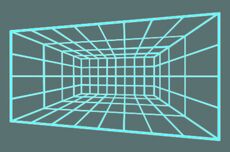Chaperone
The Chaperone system is a utility design by Valve to be used with their VR platform, SteamVR, and Head Mounted Display, the HTC Vive.
It keeps track of where a user is in relation to the physical walls around them, and if necessary, shows a blue grid[1] within the user's virtual space to notify them that they are in close proximity to a physical barrier. The HTC Vive provides tracking within an approximately 15-foot by 15-foot area, and the Chaperon system assures the users that they will not collide with any physical barriers as they experience the virtual content.
Purpose[edit]
The purpose of the Chaperone system is to warn the user when they approach a physical barrier, to which they are blind because of the headset they are wearing. This ideally prevents collisions and minimizes accidents, and thus solves the problem of real space navigation in virtual reality. The system recognizes objects and represents them in the user's field of view as glowing outlines and silhouettes. It makes it entirely possible to change position from standing to sitting on a chair, walk from object to object in real world, and safely takes advantage of all available space in a user’s room.
A secondary purpose for the Chaperone system is to allow games to interact with the user in a unique way. Because the Chaperone system has information about the user's environment, virtual applications can react to the user's surroundings. It could, for example, generate a location that matches the orientation and layout of the user's room. Conversely, the system could use techniques like overlapping spaces or directed walking[2] to make virtual environments seem much larger than the user's physical space by distorting the user's perception of distance and rotational displacement.
The latest version of Chaperone system has two modes of operation. In the first mode, the Vive is inactive until users get close to a wall or an obstacle. The headset then shows a glimpse of the real world to give users enough time to react and avoid any obstacle. The second mode is activated by double-tapping a menu button on the controller. In this mode, users see an instant view of all their surrounding.
Collision Bounds[edit]
Collision Bounds is the blue grid that appears in VR when the user is close to physical barriers in real life.
Limitations[edit]
A potential danger is the attached cord. Chaperone does not detect the cord, and it is possible for users to trip over it and fall.
Likely Additions[edit]
According to comments by the Lighthouse developers at conventions and on Twitter[3], as well as the emphasis on mapping in its patent [4], it seems likely that the HTC Vive will eventually use a stereo pair of cameras or a depth camera to aid in "detection and measurement" the user's surroundings. This might be a one-time calibration, or it could provide constantly updating information to capture changes in the user's environment. Gathering data in this fashion would also likely allow the recognition of furniture and other small objects.
Chaperone and the Guardian system[edit]
The Chaperone has been compared with the Rift’s Guardian system. Both systems enable the user to interact safely with the virtual space. However, the front camera in the Vive allows for the projection of the outside world in the virtual experience, further helping the user to avoid crashing into obstacles. The camera can also be used to find something in the room without having to remove the headset. This, according to some opinions, has given Chaperone the edge over the Guardian system.[5]
References[edit]
- ↑ Chan, N. HTC Vive vs. Oculus Crescent Bay: My 10 VR takeaways. Retrieved from http://www.tested.com/tech/concepts/504521-htc-vive-vs-oculus-crescent-bay-my-10-vr-takeaways/
- ↑ Suma, E.A., Lipps, Z., Finkelstein, S., Krum, D.M. and Bolas, M. (2012). Impossible Spaces: Maximizing natural walking in virtual environments with self-overlapping architecture. IEEE Transactions on Visualization and Computer Graphics, 18(4): 555-564
- ↑ Yates, A. (2015). Retrieved from https://twitter.com/vk2zay/status/573909197949009920
- ↑ United States Patent and Trademark Office. Chaperone. Retrieved from https://tsdr.uspto.gov/#caseNumber=86558185&caseType=SERIAL_NO&searchType=statusSearch
- ↑ Smith, S.L. (2017). Oculus Rift vs. HTC Vive: The Rift is best all around. Retrieved from https://www.tomsguide.com/us/oculus-rift-vs-htc-vive,review-3433.html
